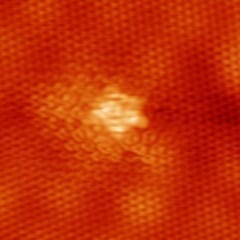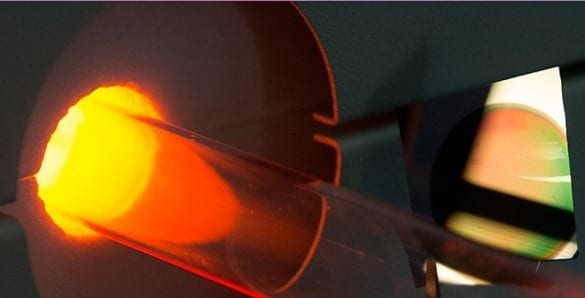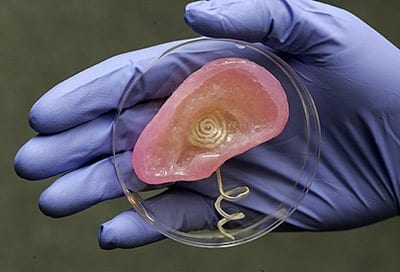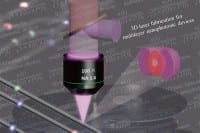
Eventually, graphene inks could lead to “applications in printable electronics like RFID tags, conductive transparent coatings, anything from sensors to flexible display applications
A digital screen that you can fold up like paper, solar cells embedded in house paint and a battery printed on the bottom of your phone — all this may soon be possible thanks to the so-called graphene ink, printed circuits made from graphene — a one-atom-thick layer of carbon that is the strongest, thinnest and most conductive material discovered yet.
Conductive inks — printed circuits — are already widely used to make touch screens, RFID tags (radio-activated ID chips) and small antennas in mobile phones. However, today’s conductive inks are usually metal-based, using materials like silver or copper powder.
These inks are expensive, can be toxic and require high temperatures to print. Graphene has long been seen as a cheaper and easier-to-use alternative, and many research teams — from Northwestern University in the U.S. to Northwestern University in the U.K. — have tried to make it work.
Among the few that seem to be succeeding is Haydale, a spin-off from Swansea University in Wales. The company currently mass-produces about one ton of graphene for commercial purposes a year — enough to make more than ten tons of conductive ink, the firm’s commercial director Ray Gibbs tells us. To make the ink, Haydale has recently partnered with Gwent Electronic Materials, a firm that supplies conductive inks for sensors and electronic instruments.
To produce the ink, Haydale uses very fine powered graphite – material widely used as lead in pencils – and puts it in a modified plasma reactor — a reactor where the plasma cloud is generated. Plasma is gas with charged particles, and the company uses it to turn the graphite into graphene. [See also Researchers Shrink Particle Accelerator to Table-top Size]
The process first purifies the graphite and then creates the one atom thick sheets of graphene. The material is then used to make the conductive ink.
Graphene-based inks are easier to handle than traditional metal-based ones, said Gibbs – less toxic, cheaper and easier to dry. If metal-based inks are not dried properly, they can swell, “which pushes the metal particles apart and reduces conductivity. Moreover, it can lead to failure when the ink is subject to bending, creasing or scratching.” Drying metal-based inks requires temperatures of 212 degrees Fahrenheit (100 degrees Celsius) or more; for graphene, about 140F (60 C) is enough.
The Latest Bing News on:
Graphene Ink
- Graphene in Biomedicine: Opportunities and Challengeson April 27, 2024 at 5:00 pm
Graphene, whose discovery won the 2010 Nobel Prize in physics, has been a shining star in the material science in the past few years. Owing to its interesting electrical, optical, mechanical and ...
- Conductive Ink Market Is Encouraged to Reach USD 5.6 Billion by 2033 at a CAGR of 6.3%on April 26, 2024 at 2:15 am
According to Market.us, the Conductive Ink Market size is projected to surpass around USD 5.6 billion by 2033, from USD 3.5 billion in 2023, and it is poised to reach a registered CAGR of 6.3% from ...
- Local twist angles in graphene come into viewon April 18, 2024 at 5:00 pm
The new technique revealed pronounced variations in local twist angles in twisted bilayer graphene. (Courtesy: S Zhu) Stacking layers of two-dimensional materials on top of each other and varying the ...
- Quantum electronics: Charge travels like light in bilayer grapheneon April 15, 2024 at 5:00 pm
In graphene, however, such a "switch" in the speed of the carrier cannot be easily achieved. In fact, graphene usually has no insulating state, which has limited graphene's potential a transistor.
- 3D Grapheneon August 13, 2020 at 6:15 pm
For instance, they show the ability of 3D-printed graphene ink scaffolds to induce neurogenic differentiation of adult mesenchymal stem cells without the need for any other neurogenic growth factors ...
- Graphene Batteries Explainedon August 13, 2020 at 12:47 pm
American Chemical Society) Even 3D-printed graphene batteries, using graphene ink, have already been demonstrated. Another exciting development is the fact that graphene allows the fabrication of ...
- Graphene Desalinates Sea Wateron March 8, 2019 at 4:03 pm
Researchers at the University of Manchester have found a way to improve a graphene-based filter mechanism that could help convert sea water to potable water. Pure graphene can do the job ...
- Scientists develop a new method to revolutionise graphene printed electronicson February 16, 2019 at 2:34 am
the team have found that using a material called dihydrolevogucosenone known as Cyrene is not only non-toxic but is environmentally- friendly and sustainable but can also provide higher concentrations ...
- Physics Is Not In Crisison January 15, 2019 at 8:17 am
Both lists lead with "magic angle" graphene, which shows superconductivity in a two-layer system where one layer is rotated by about a degree relative to the other. That's a big surprise ...
- News tagged with grapheneon January 4, 2017 at 5:24 pm
An international research team led by the University of Göttingen has demonstrated experimentally that electrons in naturally occurring double-layer graphene move like particles without any mass ...
The Latest Google Headlines on:
Graphene Ink
[google_news title=”” keyword=”Graphene Ink” num_posts=”10″ blurb_length=”0″ show_thumb=”left”]
The Latest Bing News on:
Graphene-based inks
- Tracking the opioid epidemicon April 26, 2024 at 5:00 pm
The novel device is the first to use graphene-based field effect transistors to detect four different synthetic and natural opioids at once, while shielding them from wastewater’s harsh elements. When ...
- Pacific Basin to apply graphene-based propeller coatings on 40 shipson April 26, 2024 at 10:44 am
Following successful application and obtaining positive results from the graphene-based propeller coating on one of its Supramax dry bulk vessels, Pacific Basin has started the rollout of XGIT-PROP ...
- Graphene Manufacturing Group Announces Pricing of Marketed Unit Offeringon April 26, 2024 at 8:08 am
NOT FOR DISTRIBUTION TO UNITED STATES NEWSWIRE SERVICES OR FOR DISSEMINATION IN THE UNITED STATESBase Shelf Prospectus Accessible and Prospectus ...
- Conductive Ink Market Is Encouraged to Reach USD 5.6 Billion by 2033 at a CAGR of 6.3%on April 26, 2024 at 2:15 am
According to Market.us, the Conductive Ink Market size is projected to surpass around USD 5.6 billion by 2033, from USD 3.5 billion in 2023, and it is poised to reach a registered CAGR of 6.3% from ...
- Advancing biomedical diagnostics: Graphene sensor inks pave the way for precision biosensingon April 10, 2024 at 5:00 pm
These inks have the ability to revolutionize ... and manufacture of plasma-functionalised graphene-enhanced products, all primarily based in the UK. Manufacture and sale of Silicon Carbide cutting ...
- A nitrogen boost for graphene-based supercapacitorson October 27, 2021 at 9:51 am
“Graphene-based materials are very promising electrode materials because of their high specific surface area, as well as being cheap, chemically stable, and easily producible in large quantities.
- 3D printable 2D materials based inks show promise to improve energy storage deviceson August 17, 2020 at 2:36 am
For the first time, a team of researchers, from the Department of Materials and the National Graphene Institute at The University of Manchester have formulated inks using the 2D material MXene, to ...
- Global Graphene Companies – Manufacturers and Supplierson August 14, 2020 at 11:38 pm
Graphene is the name for a honeycomb sheet of carbon atoms. It is the strongest known material, yet it is also stretchy. It can conduct electricity 100x better than silicon and heat 10x better than ...
- 3D Grapheneon August 13, 2020 at 6:15 pm
3D graphene refers to a material that consists of a graphene-based framework that has a porous, three-dimensional structure. This material can be referred to as a graphene aerogel or a 3D-printed ...
- Types of Printer Inkson July 26, 2018 at 12:26 am
Learning about the inks that are available and comparing them to your company's printing needs will help ensure you'll make the right choice when selecting a printer. Dye-Based Inks Once the only ...
The Latest Google Headlines on:
Graphene-based inks
[google_news title=”” keyword=”Graphene-based inks” num_posts=”10″ blurb_length=”0″ show_thumb=”left”]











